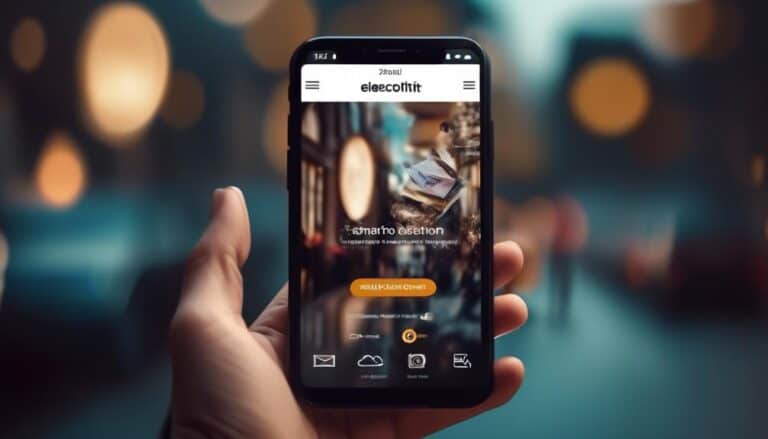Maximize Reach and Impact With Mobile-Optimized Email Content
So, you think your email content is reaching its full potential? Well, think again. In today's fast-paced digital world, where everyone is constantly glued to their smartphones, simply sending out emails is not enough.
If you truly want to make an impact and maximize your reach, you need to optimize your email content for mobile devices. But how exactly can you do that? In this discussion, we will explore the importance of mobile optimization, delve into the behavior of mobile users, and uncover the secrets to crafting engaging mobile-friendly content.
Stay tuned, because you won't want to miss out on these valuable insights.
Key Takeaways
- Mobile optimization is crucial for accessibility, engagement, and higher conversion rates.
- Understanding mobile user behavior and utilizing analytics tools can help optimize email campaigns.
- Designing for mobile responsiveness includes concise and visually appealing content, easy-to-read fonts, and testing on different devices.
- Optimizing email layout for mobile devices involves using responsive templates, clean and clutter-free layouts, and prioritizing important information at the top.
The Importance of Mobile Optimization

Mobile optimization is crucial for ensuring that your email content is accessible and engaging for the majority of your audience who are using smartphones and other mobile devices. In today's digital age, more and more people rely on their mobile devices to access emails, browse websites, and make purchases. Ignoring the importance of mobile optimization could lead to missed opportunities and decreased mobile conversion rates.
Mobile conversion rates refer to the percentage of mobile users who take desired actions, such as making a purchase or signing up for a newsletter, after interacting with your email content. Studies have shown that mobile-optimized emails have higher conversion rates compared to those that aren't optimized. By optimizing your email content for mobile devices, you can provide a seamless and user-friendly experience for your audience, increasing the chances of them taking the desired action.
Keeping up with mobile design trends is also crucial for effective mobile optimization. Mobile design trends evolve rapidly, and staying up to date with these trends can help you create visually appealing and engaging email content. Incorporating elements such as responsive design, easy-to-read fonts, and mobile-friendly layouts can enhance the overall user experience and make your emails stand out.
Understanding Mobile User Behavior
Understanding how users behave on mobile devices is crucial for optimizing your email content and ensuring that it resonates with your audience. Here are four key aspects to consider when it comes to mobile user behavior:
- Mobile User Engagement:
Mobile users have shorter attention spans and limited screen space. To capture their attention, focus on creating concise and impactful email content. Use catchy subject lines, clear and compelling calls to action, and visually appealing designs to engage them quickly.
- Mobile Conversion Rates:
Mobile conversion rates refer to the percentage of users who take a desired action, such as making a purchase or filling out a form, after interacting with your email on a mobile device. To improve conversion rates, optimize your emails for mobile responsiveness, ensuring that they're easy to read and navigate on smaller screens. Streamline the conversion process by minimizing the number of steps required.
- Mobile-Friendly Design:
Mobile users prefer emails that are visually appealing and easy to read. Use responsive email templates that adapt to different screen sizes and resolutions. Optimize images for fast loading times and consider using larger font sizes and clear, concise messaging to improve readability.
- Mobile Behavior Tracking:
Utilize analytics tools to track and analyze mobile user behavior. This will provide valuable insights into how users interact with your email content, such as which links they click on or how long they spend reading. Use this data to optimize your email campaigns and improve future engagement and conversion rates.
Designing for Mobile Responsiveness

To effectively optimize your email content for mobile users, it's essential to focus on designing for mobile responsiveness. Mobile design trends are constantly evolving, and it's crucial to stay updated with the latest practices to provide the best mobile user experience.
When designing for mobile responsiveness, consider the smaller screen size and limited attention span of mobile users. Keep your email content concise and visually appealing, using clear and easy-to-read fonts. Break up the text into smaller paragraphs and use bullet points to make it scannable.
Make sure your email template is mobile-friendly by using responsive design techniques. This means that your email should adapt to different screen sizes and orientations seamlessly. Test your email on different devices and email clients to ensure optimal display.
Additionally, optimize your images and buttons for mobile devices, making them easily clickable and responsive to touch.
Optimizing Email Layout for Mobile Devices
Ensure an optimal user experience by strategically arranging and organizing your email content for mobile devices. When it comes to mobile email design, following best practices for layout is crucial. Here are four key considerations to keep in mind when optimizing your email layout for mobile devices:
- Use responsive email templates: Responsive design allows your email to automatically adjust its layout based on the screen size of the device. By using responsive email templates, you can ensure that your content is displayed optimally on both desktop and mobile devices.
- Keep it simple and concise: Mobile screens are smaller, so it's important to keep your email layout clean and clutter-free. Focus on the most important elements and use concise and compelling copy to capture your audience's attention.
- Prioritize the top of the email: Mobile users often scroll quickly, so make sure to put your most important information at the top of the email. This includes your key message, call to action, and any relevant offers or promotions.
- Use single-column layouts: Single-column layouts work best on mobile devices as they provide a more streamlined and easy-to-read experience. Avoid using multi-column layouts as they can be difficult to navigate and may require zooming in to read the content.
Crafting Engaging Mobile-Friendly Content

Craft compelling and concise mobile-friendly content to engage your audience effectively. In today's mobile-driven world, it's crucial to have a strong mobile content strategy that resonates with your target audience. By using responsive design techniques, you can ensure that your content is optimized for mobile devices, providing a seamless and engaging experience for your readers.
When crafting mobile-friendly content, it's important to keep it concise and to the point. Mobile users have limited attention spans and are often on-the-go, so they need information that's easily digestible. Use short sentences and paragraphs, and break up your content with subheadings, bullet points, and visuals to make it more scannable.
Make sure your content is compelling and targeted to your audience's needs and interests. Use persuasive language and storytelling techniques to capture their attention and keep them engaged. Focus on the benefits and value your content provides, and use strong calls-to-action to encourage further interaction.
Remember to test your content on different mobile devices and screen sizes to ensure it looks and functions well across the board. By following these strategies, you can craft engaging mobile-friendly content that maximizes your reach and impact.
Utilizing Mobile-Friendly Call-to-Actions
Engage your mobile audience effectively with compelling and targeted call-to-actions. Mobile-friendly call-to-actions are crucial in enhancing conversion rates and improving user experience.
Here are four ways you can make your call-to-actions more mobile-friendly:
- Keep it concise: Mobile users have limited attention spans, so make sure your call-to-action gets straight to the point. Use clear and concise language that tells users exactly what action they need to take.
- Use contrasting colors: Make your call-to-action stand out by using contrasting colors that catch the eye. This will help draw attention to the button or link and make it easier for users to find and click on.
- Optimize for touch: Remember that mobile users interact with their devices using touchscreens. Ensure that your call-to-action buttons are large enough and spaced out, allowing users to easily tap on them without accidentally clicking on other elements.
- Test and optimize: Continuously test different variations of your call-to-actions to see which ones drive the highest conversion rates. Use A/B testing to experiment with different copy, designs, and placements to find the most effective combination.
Testing and Analyzing Mobile Performance

To effectively measure and optimize the performance of your mobile content, it's essential to conduct thorough testing and analysis. In today's digital landscape, mobile usage is on the rise, making it crucial for businesses to stay ahead of the curve by analyzing mobile trends and performance metrics. By doing so, you can gain valuable insights into how your mobile content is performing and make data-driven decisions to improve its effectiveness.
When it comes to testing and analyzing mobile performance, there are several key metrics to consider. These include load times, responsiveness, click-through rates, and conversion rates. By closely monitoring these metrics, you can identify any issues or areas for improvement in your mobile content.
One effective way to analyze mobile performance is through A/B testing. This involves creating multiple versions of your mobile content and testing them with different segments of your audience. By comparing the performance of these different versions, you can determine which elements are most effective in driving engagement and conversions.
In addition to A/B testing, it's important to regularly review and analyze your mobile performance data. This can provide insights into user behavior, such as how long they spend on your mobile content, which pages they visit the most, and where they drop off. Armed with this information, you can make informed decisions to optimize your mobile content and maximize its impact.
Implementing Best Practices for Mobile Optimization
Optimizing your mobile content for maximum impact requires implementing best practices that ensure a seamless user experience and drive engagement. To make the most of your mobile design, consider the following mobile design trends and best practices:
- Responsive Design: Create emails that adapt to different screen sizes and orientations. This ensures that your content looks great on any device, from smartphones to tablets.
- Simplified Layout: Keep your email design clean and clutter-free. Use minimal text and large, easy-to-read fonts. Break up content into bite-sized sections with clear headings and subheadings.
- Clear Call to Action: Make sure your call to action (CTA) stands out and is easy to tap on a mobile screen. Use a contrasting color for the CTA button and place it prominently within the email.
- Streamlined Navigation: Simplify the navigation experience for mobile users. Use a hamburger menu or a single-column layout to make it easy for recipients to find what they're looking for.
Frequently Asked Questions
What Are the Key Benefits of Mobile Optimization for Email Content?
Mobile optimization for email content offers key benefits for you. It boosts user engagement and improves email performance. By optimizing your emails for mobile devices, you can reach a wider audience and make a greater impact.
How Can I Understand My Mobile Users' Behavior and Preferences?
To understand your mobile users' behavior and preferences, use mobile analytics to track their interactions with your emails. Additionally, conduct user surveys to gather direct feedback and insights. This will help you tailor your content and optimize your email strategy for maximum impact.
What Are the Essential Elements to Consider When Designing for Mobile Responsiveness?
Consider essential elements for mobile responsiveness by following mobile design trends and best practices for mobile optimization. This will maximize reach and impact, ensuring your content is easily accessible and engaging on mobile devices.
How Can I Ensure the Email Layout Is Optimized for Different Mobile Devices?
To ensure your email layout is optimized for different mobile devices, focus on simplicity and responsiveness. Use a single-column design, large fonts, and clear call-to-action buttons. Test your emails on various devices to ensure mobile device compatibility.
What Strategies Can I Use to Create Engaging and Mobile-Friendly Content for Emails?
To create engaging and mobile-friendly content for emails, focus on creating interactive, mobile-first emails. Use responsive design techniques and optimize visuals for mobile readers. This will help maximize reach and impact.
Conclusion
In conclusion, mobile optimization is crucial for maximizing reach and impact with email content. By understanding mobile user behavior and designing for mobile responsiveness, businesses can ensure their emails are easily accessible and engaging on mobile devices.
Crafting mobile-friendly content and utilizing effective call-to-actions further enhance the effectiveness of email campaigns. Testing and analyzing mobile performance, along with implementing best practices, will help businesses stay ahead in the mobile landscape and drive better results.
Don't miss out on the opportunity to reach your audience wherever they're – optimize your emails for mobile today.








